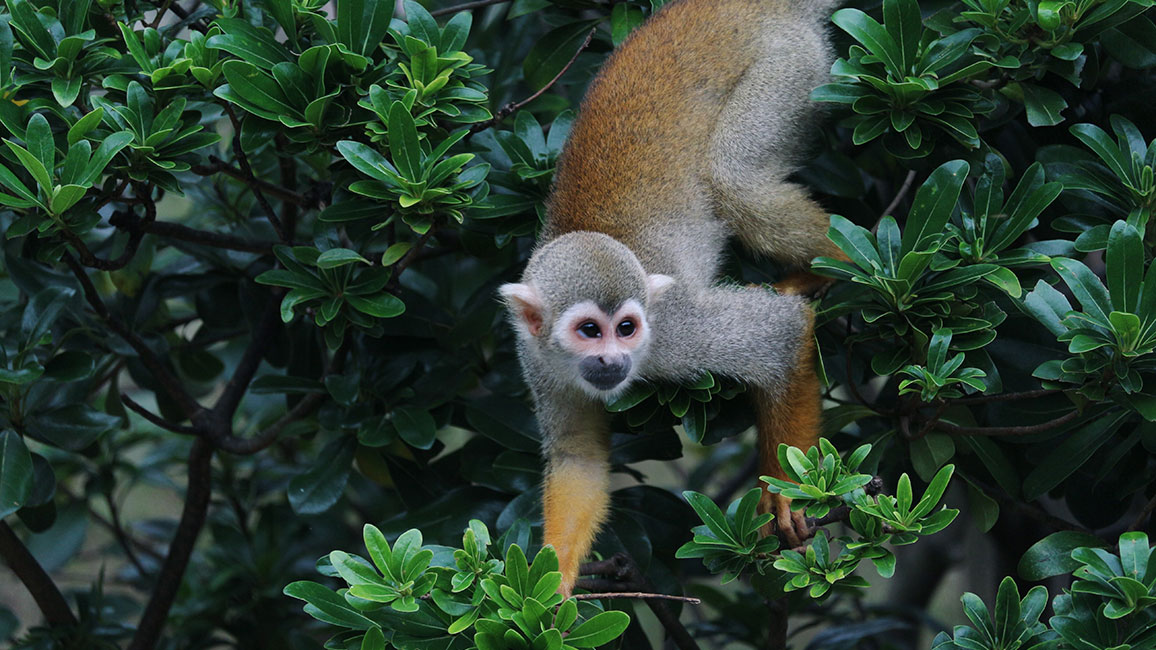
Monkey Paradise
By Ellen LambethCome visit this special place that’s perfect for monkeys.
A section of river near the equator flows gently through a misty tropical rainforest. This view from above doesn’t reveal the explosion of life going on in the forest below. The forest is in Yasuní (yah-soo-NEE) National Park in the South American country of Ecuador (see map).
Yasuní is home to many hundreds of thousands of species—from tiny insects, treetop frogs, and scurrying lizards to flitting birds, prowling mammals, and giant trees. This is just one park, with more protected land around it. But there are few—if any—other places on Earth with as many different kinds of living things in it. Here’s one amazing example of that: So far, scientists have discovered a dozen different kinds of monkeys in Yasuní. And you can meet them right here on these next few pages.
Red Howler Monkey
No alarm clock needed in this forest. At daybreak, the roars of this big monkey and its neighbors blast out a few miles in every direction from high in the treetops.
Golden-Mantled Tamarin
This small monkey prefers the lower forest layer, where it dines mostly on fruits and insects. You can tell it from other kinds of tamarins by the gold-colored fur around its shoulders. Its cousin, the red-mantled saddleback tamarin, has also been spotted in Yasuní.
Poeppig’s Woolly Monkey
As their name suggests, woolly monkeys have thick, soft, fuzzy fur. These monkeys spend most of their time way up high, munching on fruits. They help “plant” new trees when they poop out the seeds.
Equatorial Saki
Have you ever seen such a fluffy monkey before? And check out that thick, fluffy tail! All that hair makes a saki look bigger than it really is. This monkey also has a close cousin, the Napo saki, that’s named for the river on the northern border of the Yasuní region.
White-Bellied Spider Monkey
This long-armed, long-legged creature is the “Amazing Spider-Man” of the Yasuní monkey world. The furry “super hero” moves through the trees with speed and ease. Its long gripping tail comes in handy, too.
Ecuadorian Squirrel Monkey
Like squirrels that live in trees, squirrel monkeys seem always to be busy and often head down to the forest floor. There, they search for insects and other creepy-crawlies to eat. They also enjoy berries, flowers, and nectar.
Rangers: All is not perfect in paradise. Most of these monkeys are already threatened or endangered by the shrinking of their forests caused by logging, ranching, and development. And some people are tapping into oil supplies that lie in the ground underneath the forest. But other people are working hard against that. They know it could lead to pollution and more habitat loss for the monkeys and many other living things—including people—that call Yasuní home. —Ranger Rick
White-Fronted Capuchin
Sticking its tongue out at you is a small, intelligent monkey. Capuchins are most clever at using tools and solving problems. In their busy, all-day search for food, they climb high and low in the trees and everywhere in between.
Pygmy Marmoset
Meet the world’s tiniest monkey—small enough to hold in your hands. This one clings squirrel-like to a tree trunk. It’s been lapping up gummy sap that oozes out of those little holes it chewed into the bark.
Noisy Night Monkey
Night monkeys are also sometimes called owl monkeys. Not only are they active at night, but they also make owl-like hoots. In the daytime, they often hide out in tree holes, as these two are doing.
Red-Crowned Titi
This shy monkey likes to hang out low in trees near water. But it doesn’t move around much and prefers hiding among leaves and vines, so it’s easy to miss.
“Monkey Paradise” originally appeared in the March 2017 issue of Ranger Rick magazine.



















